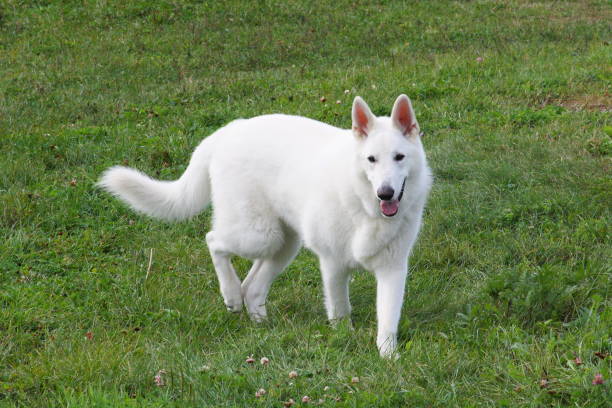White Shepherd

Breed History:
The White Shepherd originated from the same bloodlines as the German Shepherd Dog (GSD), with white-coated individuals appearing early in the breed’s history. While white was initially accepted in Germany, it was later disqualified by the German breed standard in the 1930s due to aesthetic and political reasons, not health or temperament. However, in North America, breeders continued to value and preserve the white-coated dogs for their intelligence, work ethic, and beauty.
Over time, enthusiasts developed the White Shepherd as a distinct breed, emphasising a more gentle temperament, slightly straighter backs, and, of course, the iconic white coat. The White Shepherd is recognised by the United Kennel Club (UKC) and other organisations, but it remains distinct from the White Swiss Shepherd, which has its own FCI recognition and development path.
|
Gender |
Height |
Weight |
|
Male |
60-66 cm |
30-40 kg |
|
Female |
55-61 cm |
25-35 kg |
Size – Medium-Large
Life Expectancy: 12–14 years

Breed Appearance:
The White Shepherd is an elegant, athletic dog with a strong, slightly elongated body and a level topline. Its coat is always pure white, medium-length to long, and dense and weather-resistant. The breed's expression is intelligent and noble, with erect ears, dark almond-shaped eyes, and a bushy tail carried low when relaxed.
While structurally similar to the German Shepherd, the White Shepherd often has a more level back, gentler angulation, and less exaggerated features, reflecting a shift toward a more moderate, balanced conformation.
Breed Type – Companion/Working/Family:
The White Shepherd is a versatile working dog and devoted family companion. Originally bred for herding and guarding, this breed excels today as a loyal home protector, service dog, and competitor in obedience or agility.
It is affectionate and gentle with its family, particularly children, while remaining alert and protective. White Shepherds are generally less intense and more approachable than high-drive working-line German Shepherds, making them well-suited to active family life.

Training:
White Shepherds are highly intelligent, quick to learn, and eager to please, making them ideal for a variety of dog sports and roles, from obedience to therapy work. They respond best to positive reinforcement, consistency, and mental stimulation.
Early socialisation is essential to help them grow into confident, well-rounded adults. Without proper training and engagement, they may become shy, reserved, or overly protective, especially around strangers.
Health & Care:
The White Shepherd is generally a healthy and robust breed, but it can still inherit some of the same health issues seen in German Shepherds, including:
-
Hip and elbow dysplasia
-
Degenerative myelopathy
-
Exocrine pancreatic insufficiency (EPI)
-
Allergies and skin sensitivity
Ethical breeders perform health screenings and provide guidance on diet, supplements, and exercise to support long-term well-being. The breed typically enjoys a long and active life when properly cared for.

Living Conditions:
White Shepherds are adaptable, but they thrive in environments where they have room to roam and daily mental and physical stimulation. They can live in houses with fenced yards or even in apartments, provided their exercise needs are met.
These dogs crave closeness with their family and dislike being left alone for extended periods. A bored or lonely White Shepherd may develop undesirable behaviors like chewing or barking.
Exercise:
This breed requires at least 1 to 1.5 hours of daily exercise, which should include both physical activity (like walking, jogging, or play) and mental work (training sessions, puzzle toys, scent work).
They particularly enjoy structured tasks, like agility or herding trials. Without regular activity, they may become restless or anxious, especially in their younger years.
Grooming:
The White Shepherd has a double coat that sheds year-round, with heavier shedding in spring and fall. Brushing 2–3 times per week is usually sufficient, but more frequent grooming is needed during peak shedding.
Baths are needed occasionally, and routine nail trimming, ear checks, and dental care are essential. Their white coat can pick up dirt more easily, but it is naturally clean and tend not to retain odour.

Advantages:
-
Loyal, intelligent, and easy to train
-
Striking white coat and elegant appearance
-
Great with children and family life
-
Versatile—excels in therapy, obedience, and agility
-
Calmer and less intense than working-line GSDs
-
Excellent watch and protection dog without being aggressive
Disadvantages:
-
Needs daily exercise and mental stimulation
-
Prone to separation anxiety if left alone too long
-
Moderate to heavy shedding, especially seasonally
-
May be shy or wary without early socialisation
-
Still susceptible to some inherited health issues
-
Not ideal for very sedentary or inattentive owners







